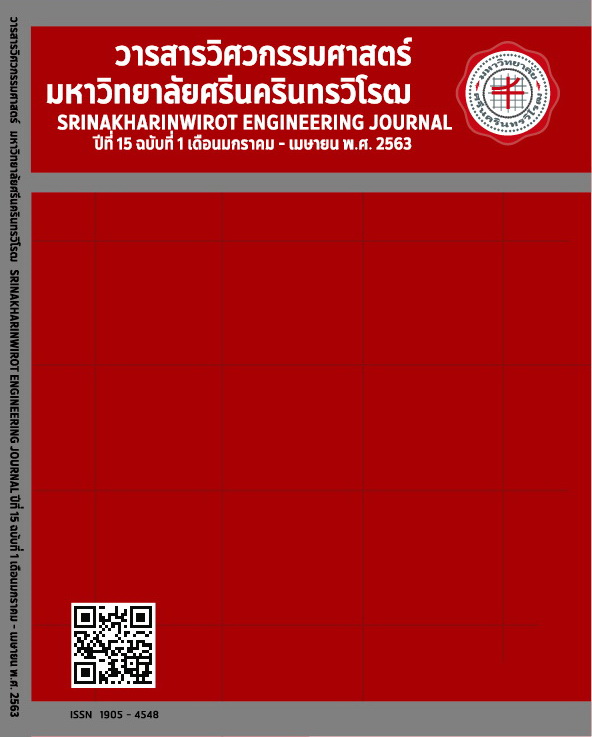Hydraulic conductivity reduction of poorly graded sand by bentonite
Main Article Content
Abstract
The main focus of this research is a study of the hydraulic conductivity of poorly graded sand by mixing with bentonite. The poorly graded sand found in the Pachi Basin are characterized by a high degree of leakage. The laboratory tests of the poorly graded sand samples resulted in a hydraulic conductivity of 119.2 mm/day and 23.16 mm/day at the bulk density of 1.69 g/cm3 and 2.25 g/cm3, respectively. The results also show that as bentonite ratios, bulk density, and curing period increase, the hydraulic conductivity is decreased. When bentonite was mixed with poorly graded sand and cured for 1 day, the hydraulic conductivity was 0.81, 0.42, 0.18 mm/day at bulk density 2.01-2.08 g/cm3 with bentonite content of 5%, 7%, and 9%, respectively. The study also found that all tested samples of bentonite poorly graded sand have acceptable hydraulic conductivity to be used in ponds. Except for soil with 5% and 7% bentonite content by weight, this is not cured and not compacted before use. This research also presents the equation for design of the bentonite ratio as an ingredient in sandy soils for another case.
Article Details
Copyright belongs to Srinakharinwirot University Engineering Journal
References
สำนักงานเศรษฐกิจการเกษตร, สถิติการเกษตรของประเทศไทย ปี 2559, กรุงเทพฯ: กระทรวงเกษตรและสหกรณ์, 2559.
จิรสรณ์ สันติสิริสมบูรณ์, การลดขนาดแบบจำลองภูมิอากาศโลกเพื่อการศึกษาผลกระทบการเปลี่ยนแปลงภูมิอากาศต่อการผลิตข้าวของประเทศไทย งานวิจัยด้านการเปลี่ยนแปลงภูมิอากาศ, กรุงเทพฯ: สำนักงานกองทุนสนับสนุนการวิจัย, 2559.
กรมพัฒนาที่ดิน. (สืบค้นเมื่อ 28 พฤษภาคม 2561) . โครงการแหล่งน้ำในไร่นานอกเขตชลประทาน [online]. Available: http://www.ldd.go.th/ WEB_Water/index.html
Jin L., Song W., Shu X., and Huang B., “Use of water reducer to enhance the mechanical and durability properties of cement-treated soil,” Construction and Building Materials. vol.159, pp. 690-694, Jan. 2018.
Bouwer, H., Ludke, J., Rice R.C., “Sealing pond bottoms with muddy water,” Ecological Engineering, vol.18, pp. 233-238, Dec. 2001.
สมชาย ดอนเจดีย์, วราวุธ วุฒิวณิชย์ และนิธิรัชต์ สงวนเดือน, “การประยุกต์ใช้ผ้าใบคอนกรีตสำหรับการชลประทาน,” ใน ชลกร ฉบับวันชูชาติ 4 มกราคม 2560, กรุงเทพฯ : สมาคมศิษย์เก่าวิศวกรรมชลประทาน ในพระบรมราชูปถัมป์, 2560, หน้า 157-166.
เจริญ นาคะสรรค์, อาซีซัน แกสมาน และอดิศัย รุ่งวิชานิวัฒน์, “ต้นแบบการทำยางปูสระน้ำจากน้ำยางธรรมชาติ,” สำนักงานกองทุนสนับสนุนการวิจัย, กรุงเทพฯ, รายงานวิจัยฉบับสมบูรณ์, 15 กุมภาพันธ์ 2550.
J. Kolawole, M. Osinuibi, M. O. Charles and A. M. Nwaiwu, “Hydraulic conductivity of compacted Lateritic soil,” Journal of Geotechnical and Geoenvironmental Engineering, vol.131, no.8, pp. 1034-1041, Aug. 2005.
A. Shahid, M. Aslam and M. Shafiq, “Reducing water seepage from earthen ponds,” Agricultural Water Management, vol.30, pp. 69-76, Mar. 1996.
ศราวุธ โกวเครือ และประทีป ดวงเดือน, (2552). “การปรับปรุงคุณภาพของดินลูกรังโดยใช้แคลเซียมคาร์บอเนตเหลือใช้จากโรงงาน,” ใน เอกสารประกอบการประชุมวิชาการโยธาแห่งชาติ ครั้งที่ 14. นครราชสีมา: มหาวิทยาลัยเทคโนโลยีสุรนารี, หน้า 281-286.
ชัชชัย พีรกมล, “การประยุกต์ใช้ดินซีเมนต์เพื่อการดาดคูส่งน้ำชลประทาน,” ปริญญานิพนธ์วิศวกรรมศาสตรมหาบัณฑิตภาควิชาวิศวกรรมชลประทาน, บัณฑิตวิทยาลัย มหาวิทยาลัยเกษตรศาสตร์, 2545.
M. H. Gleason, D. E. Daniel and G. R. Eykholt, “Calcium and sodium bentonite for hydraulic containment applications,” Journal of Geotechnical and Geoenvironmental Engineering, vol.123, no.5, pp. 438-445, May 1997.
M. A. Malusis, E. J. Barben and J. C. Evans, “Hydraulic conductivity and compresssibilty of soil-bentonite backfill amended with activated carbon,” Journal of Geotechnical and Geoenvironmental Engineering, vol.135, no.5, pp. 664-672, May 2009.
A. Norris, G. D. Emidio, M. A. Malusis and M. Replogle, “Modified bentonites for soil-bentonite cutoff wall applications with hard mix water,” Applied Clay Science, vol.158, pp. 226-235, June 2018.
J. Lin, B. Jiang and Y. Zhan, “Effect of pre-treatment of bentonite with sodium and calcium ions on phosphate adsorption onto zirconium-modified bentonite,” Journal of Environmental Management, vol.217, pp. 183-195, Jul. 2018.
H. S. Ahn and H. Y. Jo, “Influence of exchangeable cations on hydraulic conductivity of compacted bentonite,” Applied Clay Science, vol.44, pp. 144-150, Apr. 2009.
H. Komine, “Theoretical equations on hydraulic conductivities of bentonite-based buffer and backfill for underground disposal of radiaoactive wastes,” Journal of Geotechnical and Geoenvironmental Engineering, vol.134, no.4, pp. 497-508, Apr. 2008.
H. Xu, W. Zhu, X. Qian, S. Wang and X. Fan, “Studies on hydraulic conductivity and compressibility of backfills for soil-bentonite cutoff walls,” Applied Clay Science, vol.132–133, pp. 326-335, Nov. 2016.
โกวิทย์ ทศศิริ, “คุณสมบัติการไหลซึมของของไหลที่มีสารปนเปื้อนผ่านวัสดุผสมระหว่างทรายกับเบนโทไนท์บดอัด,” ปริญญานิพนธ์วิศวกรรมศาสตรมหาบัณฑิตภาควิชาวิศวกรรมโยธา, บัณฑิตวิทยาลัย จุฬาลงกรณ์มหาวิทยาลัย, 2544
E. Guler, H. O. Ozhan and S. Karaoglu, “Hydraulic performance of anionic polymer-treated bentonite-granular soil mixtures,” Applied Clay Science, vol.157, pp. 139-147, Jun. 2018.
W. J. Cho, J. O. Lee and K. S. Chun, “The temperature effects on hydraulic conductivity of compacted bentonite,” Applied Clay Science, vol.14, pp. 47-58, Feb. 1999.
W. M. Ye, Z. J. Zheng, B. Chen, Y. G. Chen, Y. J. Cui and J. Wang, “Effects of pH and temperature on the swelling pressure and hydraulic conductivity of compacted GMZ01 bentonite,” Applied Clay Science, vol.101, pp. 192-198, Nov. 2014.
C. S. Hong, C. D. Shackelford and M. A. Malusis, “Consolidation and hydraulic conductivity of zeolite-amended soil-bentonite backfill,” Journal of Geotechnical and Geoenvironmental Engineering, vol. 138, no.1, pp. 15-25, Jan. 2012.
บริษัทเทพเกษตรอุตสาหกรรม จำกัด, “รายงานผลการทดสอบโซเดียมเบนโทไนต์” สำนักวิเคราะห์วิจัยทรัพยากรธรณี กรมทรัพยากรธรณี, กรุงเทพฯ , สิงหาคม 2560.
T. W. Lambe, Soil Testing for Engineers, New York: John Wiley & Sons Publishing, 1951.
T. L. C. Morandini and A. D. L. Leite, “Characterization and hydraulic conductivity of tropical soils and bentonite mixtures for CCL purposes,” Engineering Geology, vol.196, pp. 251-267, Sep. 2015.
ทวีศักดิ์ วังไพศาล และ นท แสงเทียน, “คุณสมบัติของดินทรายปนทรายแป้งผสมเบนโทไนต์สำหรับก่อสร้างชั้นกันซึม,” วารสารวิทยาศาสตร์และเทคโนโลยี มหาวิทยาลัยอุบลราชธานี, ปีที่12 ฉบับที่1, หน้า 19-29, มกราคม-เมษายน 2553.
นันทนิตย์ เจริญไธสง, “ศักยภาพของการใช้ทรายผสมเบนโทไนต์และดินหนียวสงขลาเพื่อใช้เป็นชั้นกันซึมในสถานที่ฝังกลบมูลฝอย” ปริญญานิพนธ์วิทยาศาสตรมหาบัณฑิตภาควิชาการจัดการสิ่งแวดล้อม, บัณฑิตวิทยาลัย มหาวิทยาลัยสงขลานครินทร์, 2549.
T. Chalermyanont and S. Arrykul, “Compacted sand-bentonite mixtures for hydraulic containment liners,” Songklanakarin journal of science and technology, vol.27, no.2, pp. 313-323, 2005.
S. S. Yeo, C. D. Shackelford and J. C. Evans, “Consolidation andhydraulic conductivity of ninemodel soil-bentonite backfills,” Journal of Geotechnical and Geoenvironmental Engineering, vol.131, no.10, pp. 1189-1198, Oct. 2005.
J. S. Cramer, Mean and Variance of R2 in Small and Moderate Samples, Journal of Econometrics, vol.35, pp. 253-266, Jul. 1987.
Darlington, R., Regression and Linear Models, New York: McGraw-Hill, 1990.
สุวณี ศรีธวัช ณ อยุธยา, สมปอง นิลพันธ์, สมพงษ์ อ้นท้วม และ นฤมล จันทวัชรากร, “การประเมินค่าการสูญเสียนํ้าโดยการรั่วซึมของสระนํ้าที่ขุดในชุดดินต่างๆ บนพื้นที่ดินดอน,” กรมพัฒนาที่ดิน, กรุงเทพฯ, รายงานวิจัยฉบับสมบูรณ์, กันยายน2542.
สยาม แกมขุนทด, พานิช วุฒิพฤกษ์, สันชัย อินทพิชัย และพิทยา แจ่มสว่าง, “ตัวแปรที่มีผลกระทบต่อค่าสัมประสิทธิ์การซึมผ่านของน้ำในดินลูกรังที่มีขนาดคละแตกต่างกัน,” วารสารวิชาการพระจอมเกล้าพระนครเหนือ, ปีที่ 25 ฉบับที่ 1, หน้า 11-19, มกราคม - เมษายน 2558.


